Business Law Assignment: Ethics, Moral Rights, and Utilitarianism
VerifiedAdded on 2021/04/17
|7
|1621
|25
Homework Assignment
AI Summary
This Business Law assignment delves into normative and descriptive ethics, examining real-world scenarios like Google's employee firing based on societal perceptions. It explores moral rights, particularly in the context of freedom of expression, and analyzes utilitarianism, evaluating actions based on their consequences and impact on overall happiness. The assignment also examines virtue ethics, assessing individuals' moral character and the application of Kohlberg's stages of moral development to ethical dilemmas. The assignment uses case studies to illustrate these concepts, such as the case of Belle Gibson and the actions of Consumer Affairs Victoria, to illustrate the application of ethical frameworks in business contexts, providing a comprehensive understanding of ethical decision-making and its implications.
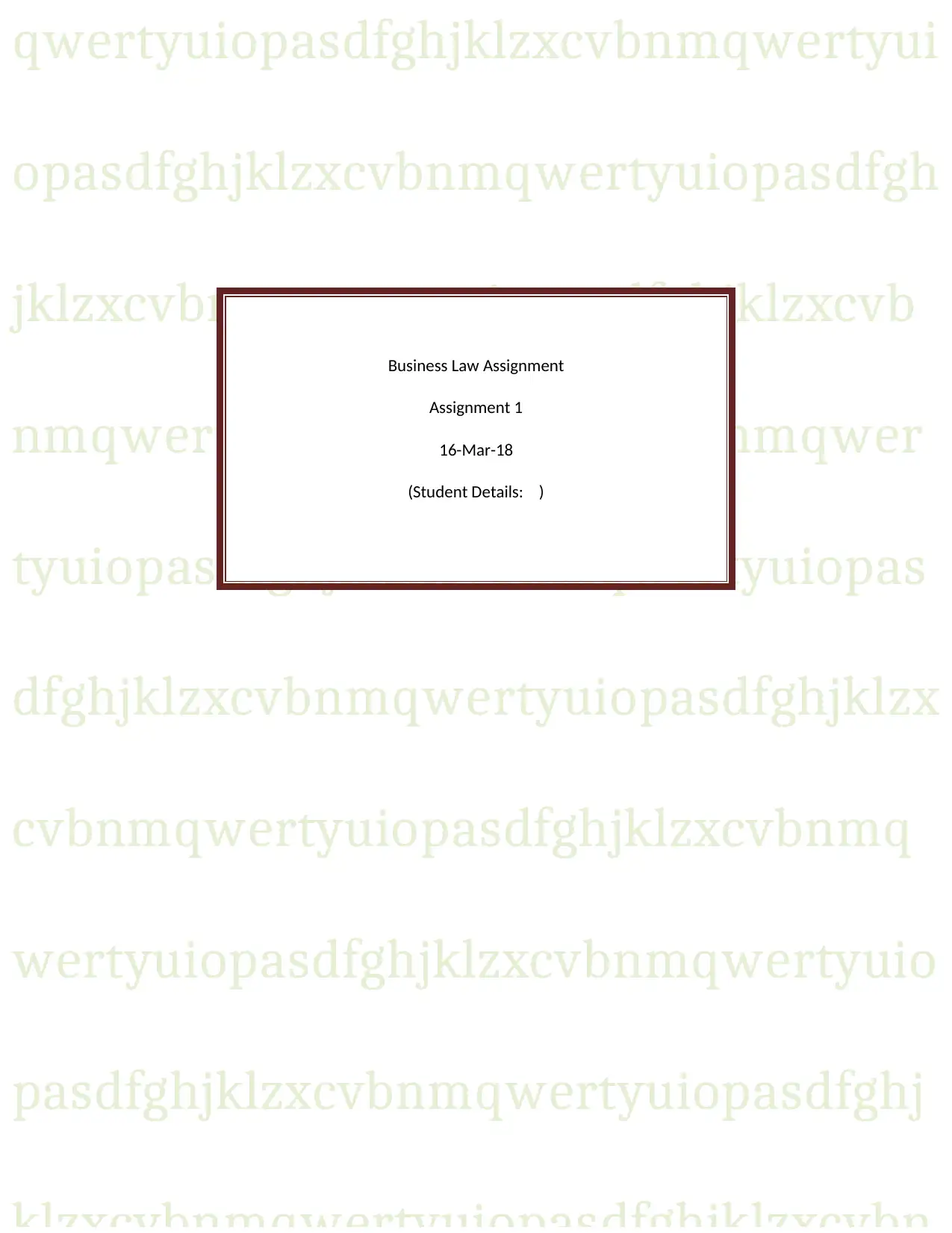
qwertyuiopasdfghjklzxcvbnmqwertyui
opasdfghjklzxcvbnmqwertyuiopasdfgh
jklzxcvbnmqwertyuiopasdfghjklzxcvb
nmqwertyuiopasdfghjklzxcvbnmqwer
tyuiopasdfghjklzxcvbnmqwertyuiopas
dfghjklzxcvbnmqwertyuiopasdfghjklzx
cvbnmqwertyuiopasdfghjklzxcvbnmq
wertyuiopasdfghjklzxcvbnmqwertyuio
pasdfghjklzxcvbnmqwertyuiopasdfghj
Business Law Assignment
Assignment 1
16-Mar-18
(Student Details: )
opasdfghjklzxcvbnmqwertyuiopasdfgh
jklzxcvbnmqwertyuiopasdfghjklzxcvb
nmqwertyuiopasdfghjklzxcvbnmqwer
tyuiopasdfghjklzxcvbnmqwertyuiopas
dfghjklzxcvbnmqwertyuiopasdfghjklzx
cvbnmqwertyuiopasdfghjklzxcvbnmq
wertyuiopasdfghjklzxcvbnmqwertyuio
pasdfghjklzxcvbnmqwertyuiopasdfghj
Business Law Assignment
Assignment 1
16-Mar-18
(Student Details: )
Paraphrase This Document
Need a fresh take? Get an instant paraphrase of this document with our AI Paraphraser
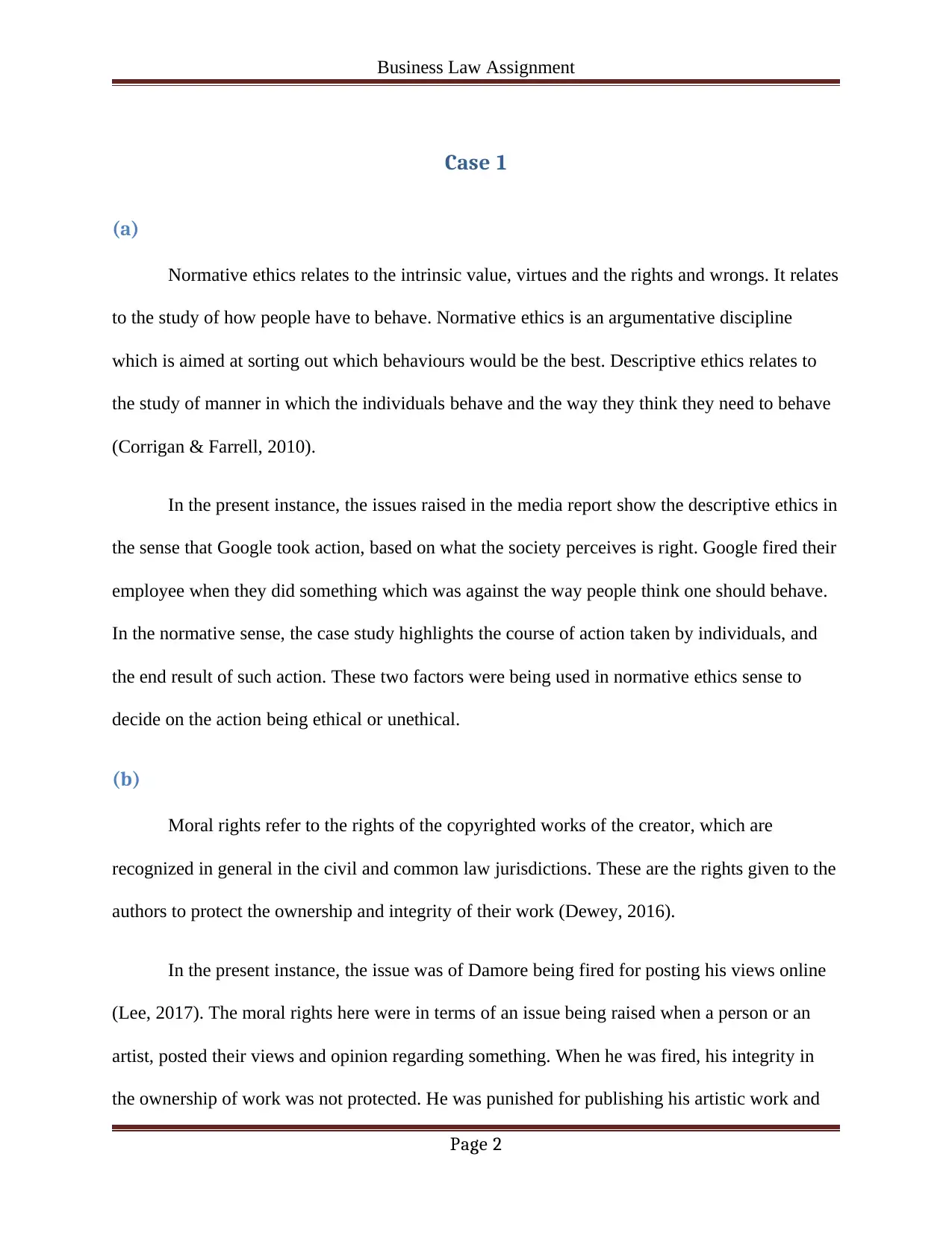
Business Law Assignment
Case 1
(a)
Normative ethics relates to the intrinsic value, virtues and the rights and wrongs. It relates
to the study of how people have to behave. Normative ethics is an argumentative discipline
which is aimed at sorting out which behaviours would be the best. Descriptive ethics relates to
the study of manner in which the individuals behave and the way they think they need to behave
(Corrigan & Farrell, 2010).
In the present instance, the issues raised in the media report show the descriptive ethics in
the sense that Google took action, based on what the society perceives is right. Google fired their
employee when they did something which was against the way people think one should behave.
In the normative sense, the case study highlights the course of action taken by individuals, and
the end result of such action. These two factors were being used in normative ethics sense to
decide on the action being ethical or unethical.
(b)
Moral rights refer to the rights of the copyrighted works of the creator, which are
recognized in general in the civil and common law jurisdictions. These are the rights given to the
authors to protect the ownership and integrity of their work (Dewey, 2016).
In the present instance, the issue was of Damore being fired for posting his views online
(Lee, 2017). The moral rights here were in terms of an issue being raised when a person or an
artist, posted their views and opinion regarding something. When he was fired, his integrity in
the ownership of work was not protected. He was punished for publishing his artistic work and
Page 2
Case 1
(a)
Normative ethics relates to the intrinsic value, virtues and the rights and wrongs. It relates
to the study of how people have to behave. Normative ethics is an argumentative discipline
which is aimed at sorting out which behaviours would be the best. Descriptive ethics relates to
the study of manner in which the individuals behave and the way they think they need to behave
(Corrigan & Farrell, 2010).
In the present instance, the issues raised in the media report show the descriptive ethics in
the sense that Google took action, based on what the society perceives is right. Google fired their
employee when they did something which was against the way people think one should behave.
In the normative sense, the case study highlights the course of action taken by individuals, and
the end result of such action. These two factors were being used in normative ethics sense to
decide on the action being ethical or unethical.
(b)
Moral rights refer to the rights of the copyrighted works of the creator, which are
recognized in general in the civil and common law jurisdictions. These are the rights given to the
authors to protect the ownership and integrity of their work (Dewey, 2016).
In the present instance, the issue was of Damore being fired for posting his views online
(Lee, 2017). The moral rights here were in terms of an issue being raised when a person or an
artist, posted their views and opinion regarding something. When he was fired, his integrity in
the ownership of work was not protected. He was punished for publishing his artistic work and
Page 2
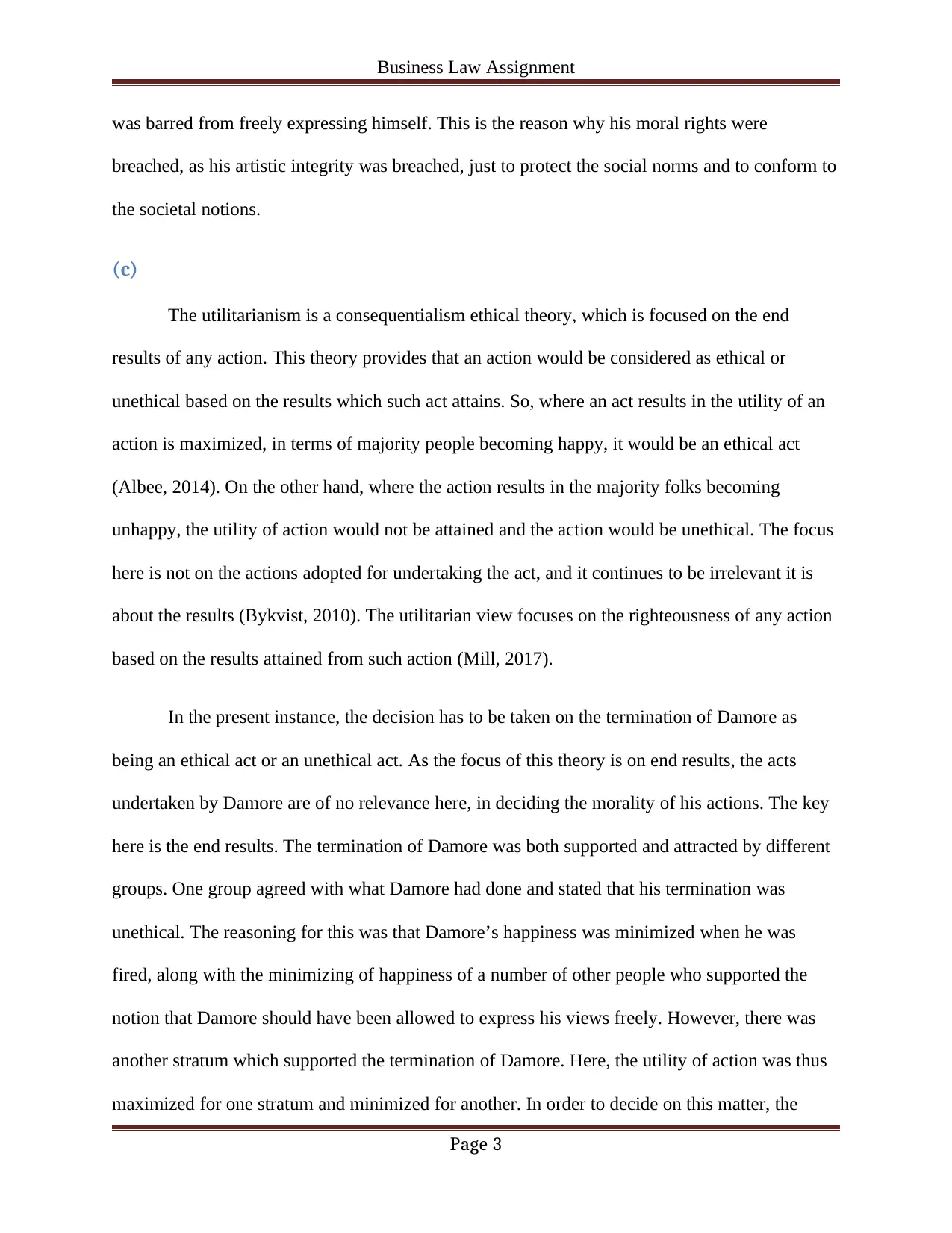
Business Law Assignment
was barred from freely expressing himself. This is the reason why his moral rights were
breached, as his artistic integrity was breached, just to protect the social norms and to conform to
the societal notions.
(c)
The utilitarianism is a consequentialism ethical theory, which is focused on the end
results of any action. This theory provides that an action would be considered as ethical or
unethical based on the results which such act attains. So, where an act results in the utility of an
action is maximized, in terms of majority people becoming happy, it would be an ethical act
(Albee, 2014). On the other hand, where the action results in the majority folks becoming
unhappy, the utility of action would not be attained and the action would be unethical. The focus
here is not on the actions adopted for undertaking the act, and it continues to be irrelevant it is
about the results (Bykvist, 2010). The utilitarian view focuses on the righteousness of any action
based on the results attained from such action (Mill, 2017).
In the present instance, the decision has to be taken on the termination of Damore as
being an ethical act or an unethical act. As the focus of this theory is on end results, the acts
undertaken by Damore are of no relevance here, in deciding the morality of his actions. The key
here is the end results. The termination of Damore was both supported and attracted by different
groups. One group agreed with what Damore had done and stated that his termination was
unethical. The reasoning for this was that Damore’s happiness was minimized when he was
fired, along with the minimizing of happiness of a number of other people who supported the
notion that Damore should have been allowed to express his views freely. However, there was
another stratum which supported the termination of Damore. Here, the utility of action was thus
maximized for one stratum and minimized for another. In order to decide on this matter, the
Page 3
was barred from freely expressing himself. This is the reason why his moral rights were
breached, as his artistic integrity was breached, just to protect the social norms and to conform to
the societal notions.
(c)
The utilitarianism is a consequentialism ethical theory, which is focused on the end
results of any action. This theory provides that an action would be considered as ethical or
unethical based on the results which such act attains. So, where an act results in the utility of an
action is maximized, in terms of majority people becoming happy, it would be an ethical act
(Albee, 2014). On the other hand, where the action results in the majority folks becoming
unhappy, the utility of action would not be attained and the action would be unethical. The focus
here is not on the actions adopted for undertaking the act, and it continues to be irrelevant it is
about the results (Bykvist, 2010). The utilitarian view focuses on the righteousness of any action
based on the results attained from such action (Mill, 2017).
In the present instance, the decision has to be taken on the termination of Damore as
being an ethical act or an unethical act. As the focus of this theory is on end results, the acts
undertaken by Damore are of no relevance here, in deciding the morality of his actions. The key
here is the end results. The termination of Damore was both supported and attracted by different
groups. One group agreed with what Damore had done and stated that his termination was
unethical. The reasoning for this was that Damore’s happiness was minimized when he was
fired, along with the minimizing of happiness of a number of other people who supported the
notion that Damore should have been allowed to express his views freely. However, there was
another stratum which supported the termination of Damore. Here, the utility of action was thus
maximized for one stratum and minimized for another. In order to decide on this matter, the
Page 3
⊘ This is a preview!⊘
Do you want full access?
Subscribe today to unlock all pages.

Trusted by 1+ million students worldwide
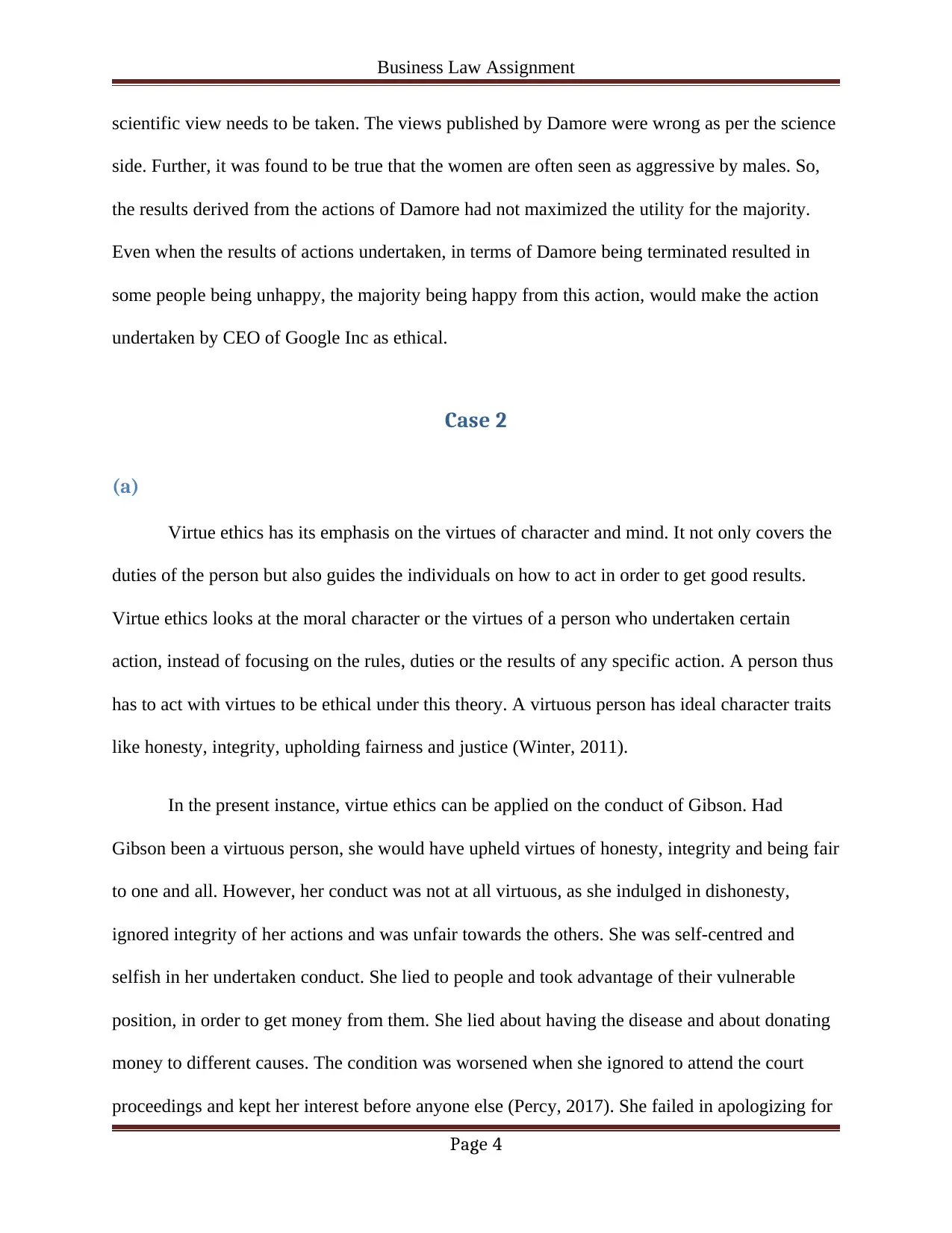
Business Law Assignment
scientific view needs to be taken. The views published by Damore were wrong as per the science
side. Further, it was found to be true that the women are often seen as aggressive by males. So,
the results derived from the actions of Damore had not maximized the utility for the majority.
Even when the results of actions undertaken, in terms of Damore being terminated resulted in
some people being unhappy, the majority being happy from this action, would make the action
undertaken by CEO of Google Inc as ethical.
Case 2
(a)
Virtue ethics has its emphasis on the virtues of character and mind. It not only covers the
duties of the person but also guides the individuals on how to act in order to get good results.
Virtue ethics looks at the moral character or the virtues of a person who undertaken certain
action, instead of focusing on the rules, duties or the results of any specific action. A person thus
has to act with virtues to be ethical under this theory. A virtuous person has ideal character traits
like honesty, integrity, upholding fairness and justice (Winter, 2011).
In the present instance, virtue ethics can be applied on the conduct of Gibson. Had
Gibson been a virtuous person, she would have upheld virtues of honesty, integrity and being fair
to one and all. However, her conduct was not at all virtuous, as she indulged in dishonesty,
ignored integrity of her actions and was unfair towards the others. She was self-centred and
selfish in her undertaken conduct. She lied to people and took advantage of their vulnerable
position, in order to get money from them. She lied about having the disease and about donating
money to different causes. The condition was worsened when she ignored to attend the court
proceedings and kept her interest before anyone else (Percy, 2017). She failed in apologizing for
Page 4
scientific view needs to be taken. The views published by Damore were wrong as per the science
side. Further, it was found to be true that the women are often seen as aggressive by males. So,
the results derived from the actions of Damore had not maximized the utility for the majority.
Even when the results of actions undertaken, in terms of Damore being terminated resulted in
some people being unhappy, the majority being happy from this action, would make the action
undertaken by CEO of Google Inc as ethical.
Case 2
(a)
Virtue ethics has its emphasis on the virtues of character and mind. It not only covers the
duties of the person but also guides the individuals on how to act in order to get good results.
Virtue ethics looks at the moral character or the virtues of a person who undertaken certain
action, instead of focusing on the rules, duties or the results of any specific action. A person thus
has to act with virtues to be ethical under this theory. A virtuous person has ideal character traits
like honesty, integrity, upholding fairness and justice (Winter, 2011).
In the present instance, virtue ethics can be applied on the conduct of Gibson. Had
Gibson been a virtuous person, she would have upheld virtues of honesty, integrity and being fair
to one and all. However, her conduct was not at all virtuous, as she indulged in dishonesty,
ignored integrity of her actions and was unfair towards the others. She was self-centred and
selfish in her undertaken conduct. She lied to people and took advantage of their vulnerable
position, in order to get money from them. She lied about having the disease and about donating
money to different causes. The condition was worsened when she ignored to attend the court
proceedings and kept her interest before anyone else (Percy, 2017). She failed in apologizing for
Page 4
Paraphrase This Document
Need a fresh take? Get an instant paraphrase of this document with our AI Paraphraser
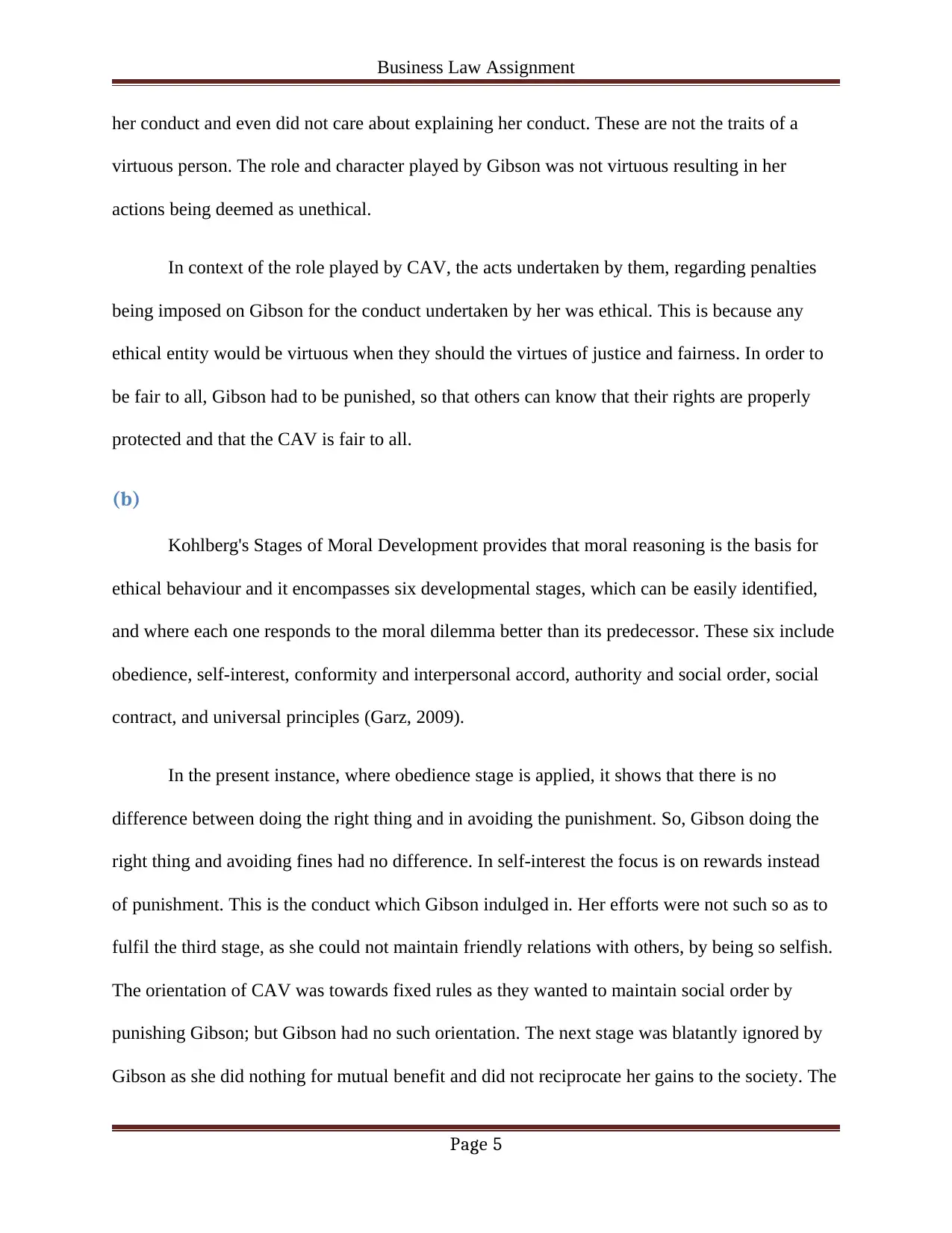
Business Law Assignment
her conduct and even did not care about explaining her conduct. These are not the traits of a
virtuous person. The role and character played by Gibson was not virtuous resulting in her
actions being deemed as unethical.
In context of the role played by CAV, the acts undertaken by them, regarding penalties
being imposed on Gibson for the conduct undertaken by her was ethical. This is because any
ethical entity would be virtuous when they should the virtues of justice and fairness. In order to
be fair to all, Gibson had to be punished, so that others can know that their rights are properly
protected and that the CAV is fair to all.
(b)
Kohlberg's Stages of Moral Development provides that moral reasoning is the basis for
ethical behaviour and it encompasses six developmental stages, which can be easily identified,
and where each one responds to the moral dilemma better than its predecessor. These six include
obedience, self-interest, conformity and interpersonal accord, authority and social order, social
contract, and universal principles (Garz, 2009).
In the present instance, where obedience stage is applied, it shows that there is no
difference between doing the right thing and in avoiding the punishment. So, Gibson doing the
right thing and avoiding fines had no difference. In self-interest the focus is on rewards instead
of punishment. This is the conduct which Gibson indulged in. Her efforts were not such so as to
fulfil the third stage, as she could not maintain friendly relations with others, by being so selfish.
The orientation of CAV was towards fixed rules as they wanted to maintain social order by
punishing Gibson; but Gibson had no such orientation. The next stage was blatantly ignored by
Gibson as she did nothing for mutual benefit and did not reciprocate her gains to the society. The
Page 5
her conduct and even did not care about explaining her conduct. These are not the traits of a
virtuous person. The role and character played by Gibson was not virtuous resulting in her
actions being deemed as unethical.
In context of the role played by CAV, the acts undertaken by them, regarding penalties
being imposed on Gibson for the conduct undertaken by her was ethical. This is because any
ethical entity would be virtuous when they should the virtues of justice and fairness. In order to
be fair to all, Gibson had to be punished, so that others can know that their rights are properly
protected and that the CAV is fair to all.
(b)
Kohlberg's Stages of Moral Development provides that moral reasoning is the basis for
ethical behaviour and it encompasses six developmental stages, which can be easily identified,
and where each one responds to the moral dilemma better than its predecessor. These six include
obedience, self-interest, conformity and interpersonal accord, authority and social order, social
contract, and universal principles (Garz, 2009).
In the present instance, where obedience stage is applied, it shows that there is no
difference between doing the right thing and in avoiding the punishment. So, Gibson doing the
right thing and avoiding fines had no difference. In self-interest the focus is on rewards instead
of punishment. This is the conduct which Gibson indulged in. Her efforts were not such so as to
fulfil the third stage, as she could not maintain friendly relations with others, by being so selfish.
The orientation of CAV was towards fixed rules as they wanted to maintain social order by
punishing Gibson; but Gibson had no such orientation. The next stage was blatantly ignored by
Gibson as she did nothing for mutual benefit and did not reciprocate her gains to the society. The
Page 5
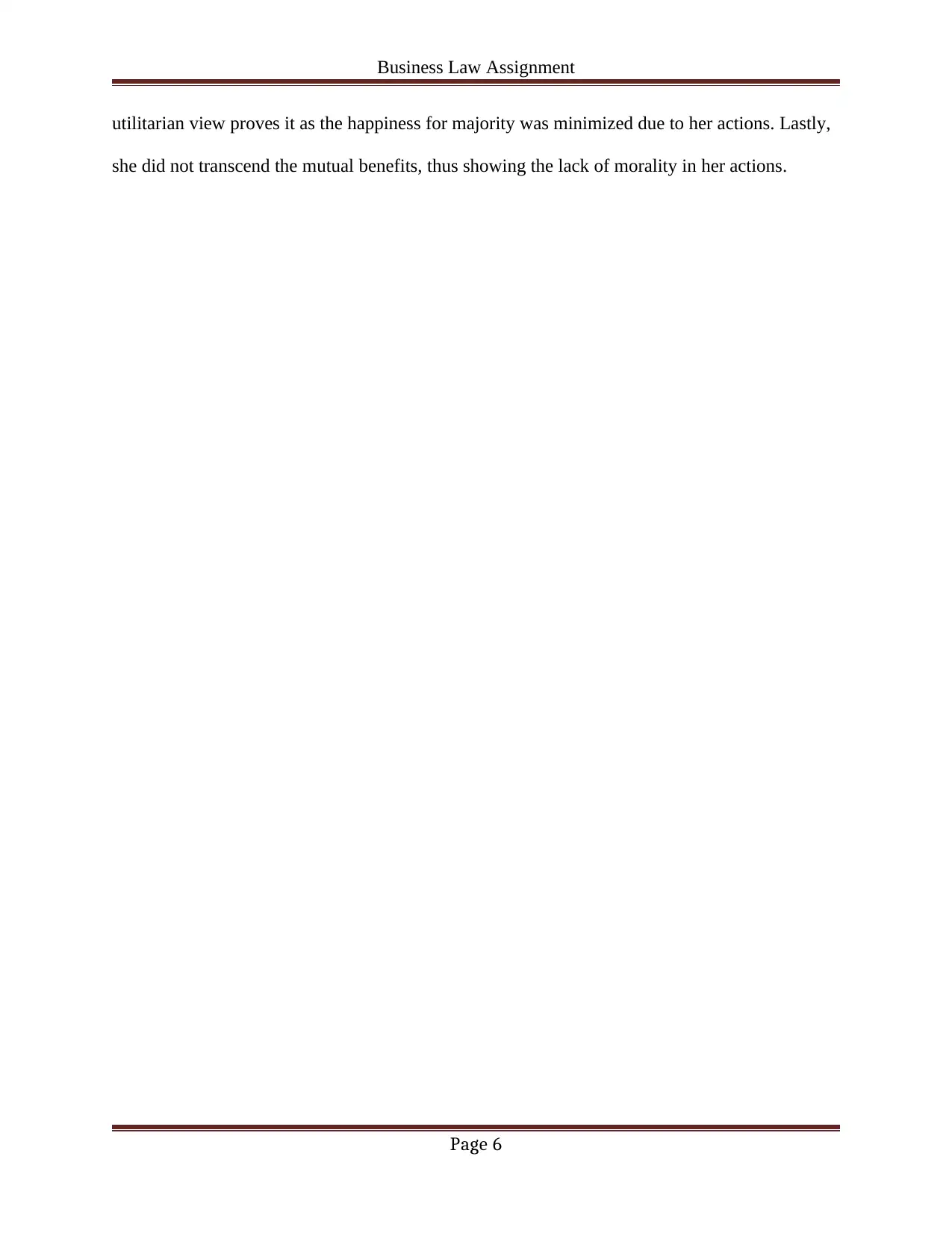
Business Law Assignment
utilitarian view proves it as the happiness for majority was minimized due to her actions. Lastly,
she did not transcend the mutual benefits, thus showing the lack of morality in her actions.
Page 6
utilitarian view proves it as the happiness for majority was minimized due to her actions. Lastly,
she did not transcend the mutual benefits, thus showing the lack of morality in her actions.
Page 6
⊘ This is a preview!⊘
Do you want full access?
Subscribe today to unlock all pages.

Trusted by 1+ million students worldwide
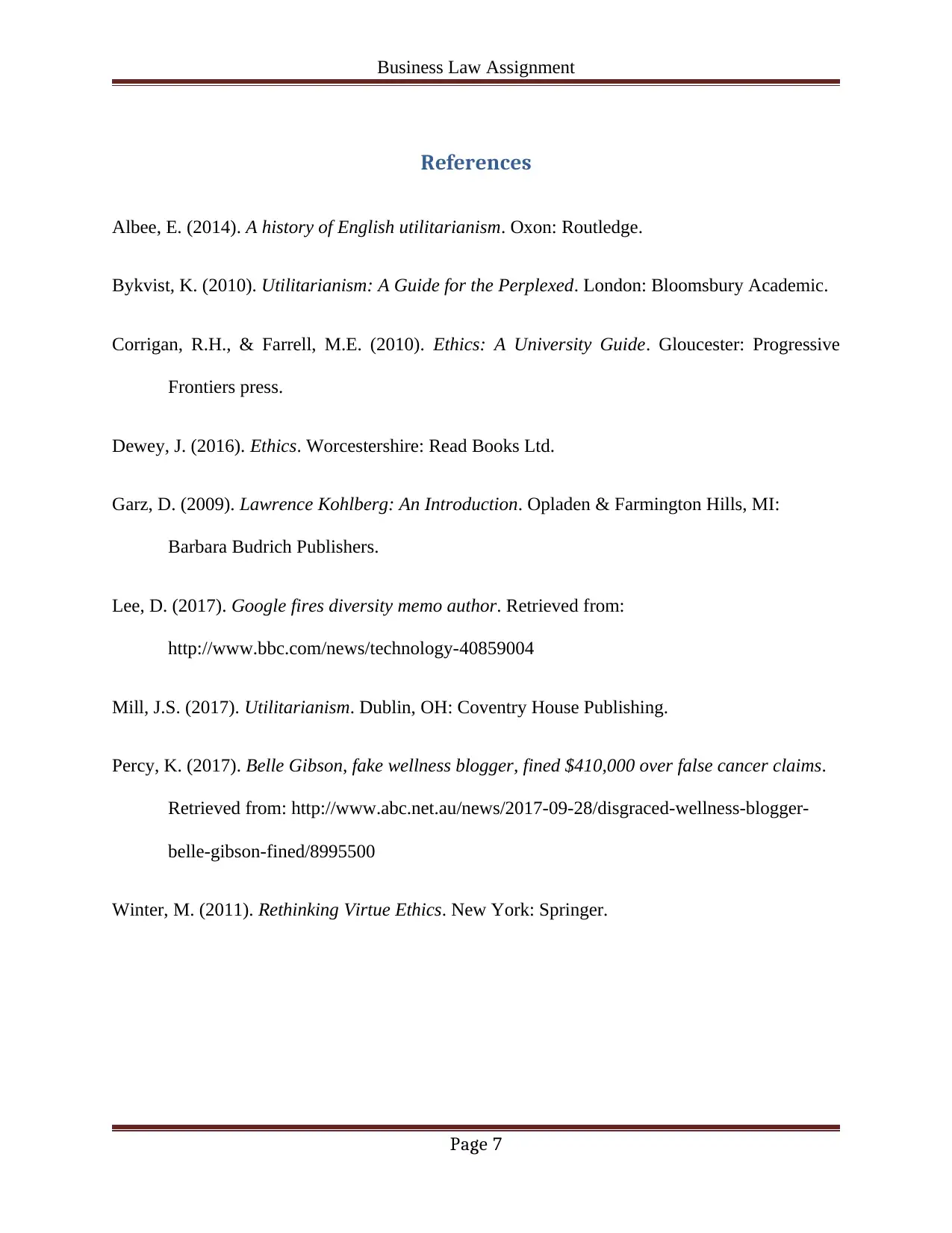
Business Law Assignment
References
Albee, E. (2014). A history of English utilitarianism. Oxon: Routledge.
Bykvist, K. (2010). Utilitarianism: A Guide for the Perplexed. London: Bloomsbury Academic.
Corrigan, R.H., & Farrell, M.E. (2010). Ethics: A University Guide. Gloucester: Progressive
Frontiers press.
Dewey, J. (2016). Ethics. Worcestershire: Read Books Ltd.
Garz, D. (2009). Lawrence Kohlberg: An Introduction. Opladen & Farmington Hills, MI:
Barbara Budrich Publishers.
Lee, D. (2017). Google fires diversity memo author. Retrieved from:
http://www.bbc.com/news/technology-40859004
Mill, J.S. (2017). Utilitarianism. Dublin, OH: Coventry House Publishing.
Percy, K. (2017). Belle Gibson, fake wellness blogger, fined $410,000 over false cancer claims.
Retrieved from: http://www.abc.net.au/news/2017-09-28/disgraced-wellness-blogger-
belle-gibson-fined/8995500
Winter, M. (2011). Rethinking Virtue Ethics. New York: Springer.
Page 7
References
Albee, E. (2014). A history of English utilitarianism. Oxon: Routledge.
Bykvist, K. (2010). Utilitarianism: A Guide for the Perplexed. London: Bloomsbury Academic.
Corrigan, R.H., & Farrell, M.E. (2010). Ethics: A University Guide. Gloucester: Progressive
Frontiers press.
Dewey, J. (2016). Ethics. Worcestershire: Read Books Ltd.
Garz, D. (2009). Lawrence Kohlberg: An Introduction. Opladen & Farmington Hills, MI:
Barbara Budrich Publishers.
Lee, D. (2017). Google fires diversity memo author. Retrieved from:
http://www.bbc.com/news/technology-40859004
Mill, J.S. (2017). Utilitarianism. Dublin, OH: Coventry House Publishing.
Percy, K. (2017). Belle Gibson, fake wellness blogger, fined $410,000 over false cancer claims.
Retrieved from: http://www.abc.net.au/news/2017-09-28/disgraced-wellness-blogger-
belle-gibson-fined/8995500
Winter, M. (2011). Rethinking Virtue Ethics. New York: Springer.
Page 7
1 out of 7
Related Documents
Your All-in-One AI-Powered Toolkit for Academic Success.
+13062052269
info@desklib.com
Available 24*7 on WhatsApp / Email
![[object Object]](/_next/static/media/star-bottom.7253800d.svg)
Unlock your academic potential
Copyright © 2020–2025 A2Z Services. All Rights Reserved. Developed and managed by ZUCOL.





